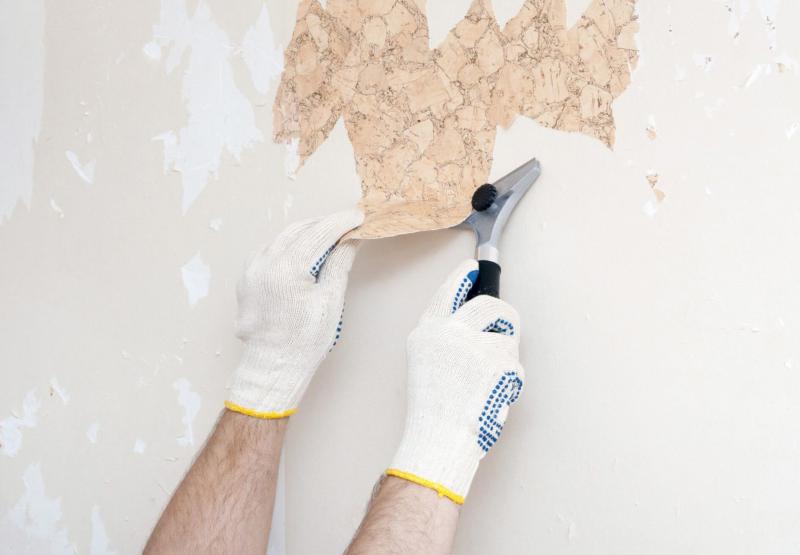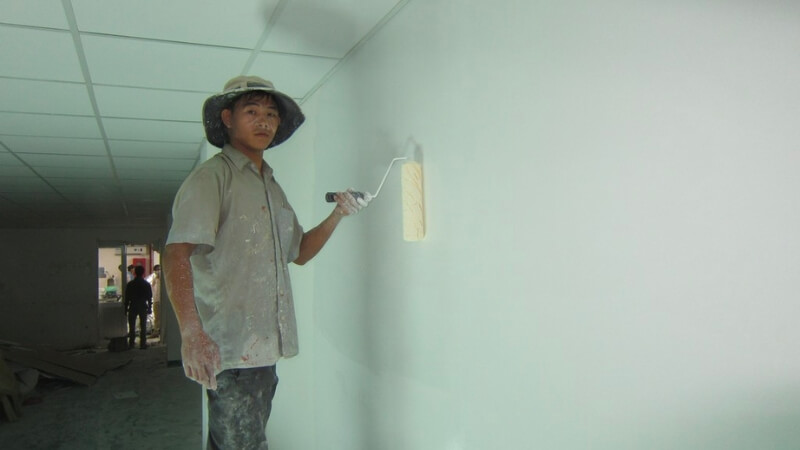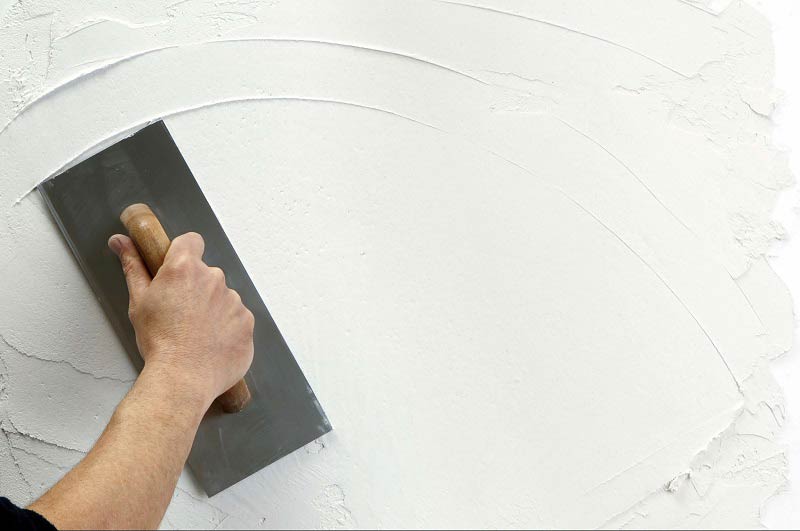1 Steps to repaint the walls properly
Step 1 Clean and prepare the surface
Before starting the process, make sure to remove all moss, dirt, impurities, and any peeling paint or plaster on the old wall surface.
If the surface to be repainted is still new, use a grinding stone or sandpaper to create a good adhesive surface before applying the new paint layer. As for older wall surfaces, after cleaning, wash them with clean water, let them dry, and then proceed with the painting process.
 Clean and prepare the surface
Clean and prepare the surface
Some surface treatment methods:
- Surface with dirt or powder: Clean with high-pressure water or use a mild cleaner. If the surface has a lot of powder, apply two layers of alkali-resistant primer after cleaning the surface.
- Surface with old paint/plaster: Old paint layers must be removed by scraping or using appropriate tools. If the surface is not smooth, it should be filled with suitable putty.
- Surface with moss/mold: Clean with water using high pressure or using tools to remove and treat with specialized anti-moss, anti-mold solutions. Then, rinse again and let it dry.
- Surface with oil/grease: Use a degreaser and a little solvent (if necessary) to remove the oil stains. Then, rinse thoroughly to remove all traces of oil.
Step 2 Apply waterproof paint to the walls
This step is necessary for surfaces that are not decorated or painted. Applying waterproof paint will protect against the effects of moisture. To achieve the desired effect, choose a good quality cement-based waterproof paint.
 Apply waterproof paint to the walls
Apply waterproof paint to the walls
Step 3 Apply putty
This is the stage where you can fill in cracks and imperfections to create a smooth surface for interior and exterior walls before applying primer and topcoat. However, depending on the purpose and usage requirements, this step may or may not be necessary.
 Apply putty
Apply putty
Step 4 Apply alkali-resistant primer
First, stir the primer thoroughly. Then, use a roller to apply this step. Depending on your needs and conditions, you can apply 1 or 2 coats of alkali-resistant primer. Make sure there is at least 1 hour gap between each coat to ensure the necessary drying time.
In addition, you can add 5 – 10% clean water by volume before application. This will maximize coverage and make it easier to apply.
 Apply alkali-resistant primer
Apply alkali-resistant primer
Step 5 Apply the topcoat
In this step, we will apply 2 coats of topcoat.
Coat 1:
After a minimum of 2 hours to let the alkali-resistant primer dry, we can proceed to paint the first coat.
You can use a paint sprayer, brush, or roller depending on the specific wall surface. Dilute the paint with 5 – 10% clean water by volume before application for maximum coverage and ease of application.
After painting, carefully observe any remaining imperfections from previous steps and fix them before painting the second topcoat.
Coat 2:
 Apply the topcoat
Apply the topcoat
Similarly, after a minimum of 2 hours to let the first topcoat dry, proceed to paint the second coat of topcoat.
Using the same painting tools as the first coat, be careful as this is the final finishing coat.
After finishing, use a spotlight to shine on the wall and observe. If the topcoat is even, without any color differences, marks, and the wall surface is evenly bright, then it is considered successful.
2 Tips for calculating the appropriate amount of paint to buy
You can use the following method to calculate the amount of paint needed:
Area to paint inside the house = (Area x Number of floors) x Coefficient for painting inside the house
In which:
The coefficient for painting inside the house ranges from 3 to 4.5.
– If it’s a single-story house without a ceiling – Coefficient: 3
– If it’s a single-story house with few doors – Coefficient: 3.5
– If it’s a multi-story house with moderate door to room ratio – Coefficient: 4
– If it’s a multi-story house with fewer doors and windows – Coefficient: 4.5
Note:
The above coefficient is accurate when calculating the overall area of a house, but not for each individual room.
Area to paint outside the house = Area of the front facade x Coefficient for painting outside the house
Where, the coefficient for painting outside the house ranges from 1.2 to 1.8, depending on the level of decorative details.
 Calculate the appropriate amount of paint to buy
Calculate the appropriate amount of paint to buy
Example: Assuming the house has a width (or horizontal measurement) of 5m, length (or depth) of 10m, 3 floors, each floor is 4m high (or there is a balcony), and the house is 1.5m wide, the amount of paint required is calculated as follows:
Calculate the area to paint inside the house
Area to paint inside the house = (5 x 10 x 3) x 4 = 600 m2
Case 1: Rolling the paint directly without primer
Quantity of paint for the house = Area to paint inside the house / Standard of 1 bucket (18 liters) that can cover 4 layers
From the above example, you can calculate as follows:
Quantity of paint for the house = 600 / 5 = 12 buckets of 18 liters.
In which:
– Quantity of primer paint (white paint) accounts for 2/3 = 8 buckets.
– Quantity of colored paint = 4 buckets.
Case 2: Using primer
According to the process of painting the inside of the house with primer, you have to roll 3 layers including 1 layer of primer (white paint) and 2 layers of topcoat (colored paint).
Where:
– 1 bag of putty (40 kg) can cover 40m2 (2 layers).
Quantity of putty for the house = Area to paint inside the house / Standard of 1 bag of putty for the house = 600/40 = 15 bags.
– 1 bucket of interior paint (18 liters) can cover 200m2 for 1 layer, and 70m2 for 3 layers.
Quantity of paint for the house = Area to paint inside the house / Standard of 1 bucket (18 liters) to roll 3 layers = 600/70 = 9 buckets of 18 liters.
In which:
– Quantity of white paint accounts for > 1/2 = 5 buckets of 18 liters
– Quantity of colored paint accounts for < 1/2 = 4 buckets of 18 liters
Calculate the area to paint outside the house
Area to paint outside the house = (5 x 4 x 3) x 1.5 = 90m2
Case 1: Rolling paint directly without primer
According to the process of painting outside the house without primer, you have to roll 4 layers including 2 layers of alkali-resistant primer (or white paint) and 2 layers of topcoat (colored paint)
Where:
– 1 bucket of alkali-resistant primer (18 liters) can cover 120m2 for 2 layers
– 1 can of alkali-resistant primer (5 liters) can cover 30m2 for 2 layers
– 1 can of colored paint (5 liters) can cover 30m2 for 2 layers
Quantity of alkali-resistant primer = Area to paint outside the house / Standard of 1 can of alkali-resistant primer to roll 2 layers = 90 / 3 = 3 cans of 5 liters
Quantity of colored paint = Area to paint outside the house / Standard of 1 can of exterior topcoat to roll 2 layers = 90 / 30 = 3 cans of 5 liters
In which:
– Color as the background accounts for 2/3 = 2 cans of 5 liters
– Color as the trim accounts for 1/3 = 1 can of 5 liters
3 Some notes when repainting the walls for Tet
 Some notes when repainting the walls
Some notes when repainting the walls
- Handle paint cans carefully and place them in a safe location. In case of spills, clean them up with soil and sand.
- Wear appropriate masks during the entire painting process.
- Ensure good ventilation during the painting process. If conditions are not naturally well-ventilated, you need to have supportive devices such as electric fans.
- Avoid inhaling paint dust.
- If paint accidentally gets into the eyes, immediately rinse with clean water, then go to the nearest medical facility for treatment.
- Do not dispose of excess or expired paint into the environment. If necessary, dispose of them in strict accordance with environmental protection regulations.
4 Tips for choosing the right paint and type of paint
Reviews of paint brands on the market
Jotun Paint (Norway)
Jotun Paint (Norway)
Advantages:
- High ability to resist bacteria.
- Diverse range of sizes that are easy to choose for construction.
- High resistance to mold, peeling, and color fading.
- Provides cost-effective interior paint with high coverage due to its high acrylic content.
Disadvantages:
- Jotun paint is slightly expensive.
Price range: Jotun offers paint solutions for 4 main areas such as Industrial Paint, Marine Paint, Electrostatic Paint, and Decorative Paint in the price range of approximately 40,000 – 55,000 VND/m2 for 2 layers of paint.
Dulux Paint (Netherlands)
Dulux Paint (Netherlands)
Advantages:
- A wide range of colors with 2,000 options, advanced European standard technology.
- Considered a human-friendly paint, non-allergenic.
- High moisture and mold resistance thanks to its alkali-resistant properties.
Disadvantages:
- Has a limited color palette compared to other brands.
Price range: Available at a price range of approximately 40,000 – 50,000 VND/m2 for 2 layers of paint.
Maxilite Paint
Maxilite Paint
Advantages:
- High coverage, cost-effective, and easy to apply.
- Paint has good resistance to dust, moisture, and mildew, protecting the walls for a long time.
- Diverse color choices and long-lasting wall protection.
Price range: Available at a price range of approximately 35,000 – 45,000 VND/m2 for 2 layers of colored paint.
Determine whether it is an interior or exterior paint
 Determine whether it is an interior or exterior paint
Determine whether it is an interior or exterior paint
Interior paint is produced for use inside the house. It has the advantage of smoothness, gloss, and color durability over time.
On the other hand, exterior paint is used when painting the outside of a building. It has the notable advantage of withstanding the harsh effects of weather conditions, and is resistant to mildew and mold on walls.
Tips for coordinating colors
 Tips for coordinating colors
Tips for coordinating colors
When preparing to paint your walls, you will surely ask what color paint should be chosen? How should we choose the colors of wall paint… In practice, the choice of suitable wall paint colors will include the following factors:
- Feng shui factor: Currently, color is considered an element that needs to be chosen in accordance with feng shui. Each homeowner will be suitable for certain colors that enhance their luck. However, some color choices may clash with the homeowner’s zodiac sign and bring about unlucky events.
- Architectural style of the house: Choosing colors for a garden house will be different from choosing colors for a tube house. Colors for a classic-style house will be different from modern-style houses. Therefore, choosing house paint colors such as white or blue will depend on a part of your home’s architecture.
- Personal preferences for paint colors: You need to consider whether to choose elegant house paint colors or ones that express your personal style, leaning towards classical elements, etc.
- Space availability to paint: Choosing colors for a small area will be different from choosing colors for a large area. Normally, small houses will choose simple, bright colors to increase brightness and spaciousness. In contrast, large spaces can choose modern colors such as dark colors to bring out luxury.
- Depending on whether it’s interior or exterior paint: Choosing colors for exterior walls may differ from interior walls because it also depends on factors such as color durability, the effects of moisture, light, and dirt.
Therefore, how to view wall paint colors or how to choose beautiful wall paint colors will require a comprehensive evaluation, combining harmonious elements that influence the choice of wall paint colors, house paint colors.
Source: Kayerr.vn












